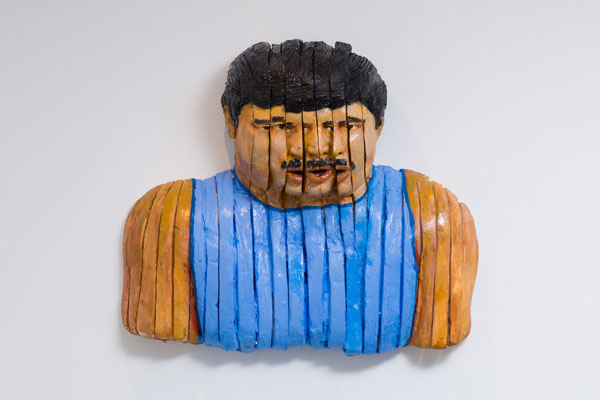“The Bronx Comes to LA” features artworks from the larger body of work set up in Bronx storefronts by John Ahearn and Rigoberto Torres, dating from 1990 to 2020. The life casting process for making the figures is fairly complicated, but even more importantly, requires a very trusting relationship between the person applying the mold-making alginate and the sitter who must breathe through small straws as the goopy green liquid sets up. Afterward, there still needs to be a plaster external cast made so the person must continue to be patient, staying immobile while it all coalesces. When these molds are finally cast, the artists intervene with paint to build back the person being portrayed.
One of the figures, Ingrid (1992/2002), is concentrated on a shelf in front of her. Jutting out from the wall, the green squared counter is being scrubbed with a bright blue dishrag while on the left side is a bunch of green bananas and on the other side is a can of jalapeno peppers. There’s something majestic about this simple set of gestures. Its everyday quality is offset in part by the bright colors of the red sweater and yellow glasses, but in the end, there’s something equally monumental and intimate about it.

Top: John Ahearn, Rigoberto Torres, Split Portrait (1997-2000), Courtesy Charlie James Gallery.
Mounted on the wall above the door leading into the gallery, Ismael (Tire Shop), (2017) leans out with an impact wrench in hand. Observed up close there are clearly marks of sculptural modification on these cast plaster surfaces. Small grooves, crosshatching and careful treatments of the surface emerge and the paint is drawn out of the representational into the expressive. There is a compelling mix of recognizability and abstraction.
In a smaller back room, the two artists, as well as Ahearn’s wife Juanita and child Carlos, are portrayed. The very disconcerting white eyes of Ahearn and the extremely bright orange T-shirt of Orange Self (2010) is across from the fractured and reconstructed vertical slices of Split Portrait (1997–2000) of Rigoberto. Together, they foreground the emotional engagement of the artists. It is what allows them to make such captivating and individualized portraits.
What is most compelling about this work overall is not only the social context from which it emerges but the way it documents the inhabitants of the area around where the artists live and work. There is something very discerning yet participatory about making life-size portraits of the people around where they are living and having that portrayal completed in public view.


